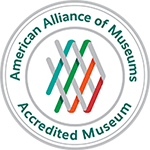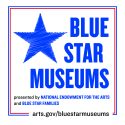Museums, and perhaps most particularly art museums, have roles to play in connecting the lives of their visitors with the history of their communities and their country.
History becomes illuminating when it’s tied to the present. Museums can, for their audiences, facilitate this connecting work of history to the world today.
Art museums themselves have to be current and as connected to the present as they are about studying the past.
Museums endeavor to be relevant in the traditional sense but also in new ways that challenge old school ways. The Innovation & Tradition in American Art permanent collection traces American history from late 19th century to the postmodern. Photo: R.Freeman
The Innovation & Tradition in American Art permanent collection traces American history from late 19th century to the postmodern. Photo: R.Freeman
 SRO at the February 2018 opening of the “Savage” Happening at Cedarhurst. Photo: R.Freeman
SRO at the February 2018 opening of the “Savage” Happening at Cedarhurst. Photo: R.Freeman
Museums endeavor to present History as critically important for understanding our current moment.
Reading objects in historical contexts that speak to today is what art museums specialize in.
Everyone reads cultural objects through the many languages they are born into and those they cultivate. All the arts — books, painting, sculpture, architecture, photography, movies, music, dance, theatre — play fundamental roles in signposting what is significant in culture today. Museums have tools to share on how to read objects in context. The tools are offered to visitors to determine what is relevant.
 William Glackens, Summer Day, Bellport, Long Island, 1913, Oil; Julien Weir, The Feather Boa, 1890, Oil; Collection of Cedarhurst, Photo: R. Freeman
William Glackens, Summer Day, Bellport, Long Island, 1913, Oil; Julien Weir, The Feather Boa, 1890, Oil; Collection of Cedarhurst, Photo: R. Freeman
Form, Mood, Function, Social Values, and Historical Contexts are my main themes when considering what goes into and comes out of cultural objects. Just the study of Form alone expands into the artwork’s material connotations, the influence of style, and semiotics.
 The audience turns as guest artist Margaret Keller (podium, far right) makes a point about her watercolors. At the Leaning on Nature exhibition, February 23, 2020. Photo: R. Freeman
The audience turns as guest artist Margaret Keller (podium, far right) makes a point about her watercolors. At the Leaning on Nature exhibition, February 23, 2020. Photo: R. Freeman
Dominant themes in American art are established in the works of the Ashcan School and Paul Strand. Each in their own ways looked to represent people and aspects of American life that were often overlooked. Their art and photography became the recognition of people from everyday life. Typically, back in their era, only prominent people and events were portrayed in oil or made into statues. Later, Pop Art continued the recognition of everyday life. Postmodernism looked closer at the social values in everyday life.
 Marilyn Boysen, Spring, Summer, Autumn, Winter, all works 1995-2003, bird feathers, exotic woods, various media. Roberta Elliot, themed seasons stands for masks, 2009, hand-wrought metal. All Permanent Collection of Cedarhurst. Photo: R. Freeman
Marilyn Boysen, Spring, Summer, Autumn, Winter, all works 1995-2003, bird feathers, exotic woods, various media. Roberta Elliot, themed seasons stands for masks, 2009, hand-wrought metal. All Permanent Collection of Cedarhurst. Photo: R. Freeman
Museums and its curators are challenged with how to make collections accessible and relevant to a wide range of people. Curatorial work begins in scholarship.
Smithsonian Secretary Lonnie Bunch said, “Scholarship should shape what you do in part because it gives you credibility…. You can be stopped if your scholarship isn’t sound.”
Museums are not only for experts. The very scholarship that attracts experts can also be conveyed to diverse spectrums of people. Curators are the liaisons.
Art Museums can be at the center of their communities helping to understand the social and democratic challenges in a world where lives are dominated by the risks of economic collapse, ecological catastrophes, rise of totalitarianism, and warfare.
A museum’s raison d’être begins introspectively improving the institution itself.
Cedarhurst has always reviewed its past adjusting to ensure that it is relevant to its community, a welcoming space for all people.
 The Mount Vernon Township High School Future Farmers of America exhibit May – July 2018. Photo: R.Freeman
The Mount Vernon Township High School Future Farmers of America exhibit May – July 2018. Photo: R.Freeman
Being inclusive is a day-to-day commitment; a transformative commitment. Diversity is another name for democracy. Diversity embraces tradition and innovation. It’s what we strive for at Cedarhurst.
 Bruno Moser discussed his collection in The Beauty of Function exhibition October 2015. Photo: R. Freeman
Bruno Moser discussed his collection in The Beauty of Function exhibition October 2015. Photo: R. Freeman
I have a sense that museums have long functioned as micro-forums of democracy who gather diverse audiences to discuss the representations of culture.
Museums, though not perfect, continue to shift towards the needs of their audiences becoming more involved as social agents of change.
Artists in our collections, like myself, believe in the power of representation.
Representations can bestow meaning, authority, and prestige on the person, object, or idea being depicted. Visual artists, musicians, and poets reconfigure “our lived lives” into art.
The Cedarhurst artists who historically recognized the contradictions of those who had been under-represented are: Robert Henri, Mary Cassatt, Thomas Eakins, Paul Strand, George Luks, Maurice Prendergast, Arthur B. Davies, William Glackens, Childe Hassam, John Singer Sargent, and George Bellows.





